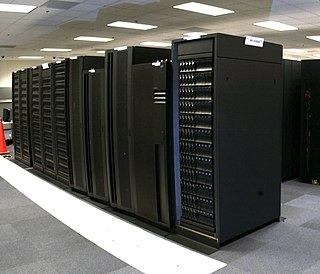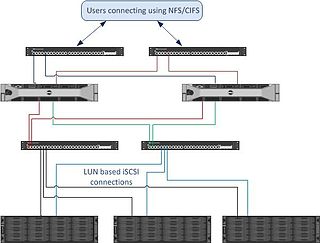Related Research Articles

Network-attached storage (NAS) is a file-level computer data storage server connected to a computer network providing data access to a heterogeneous group of clients. The term "NAS" can refer to both the technology and systems involved, or a specialized device built for such functionality.
NetApp, Inc. is an American data infrastructure company that provides unified data storage, integrated data services, and cloud operations (CloudOps) solutions to enterprise customers. The company is based in San Jose, California. It has ranked in the Fortune 500 from 2012 to 2021. Founded in 1992 with an initial public offering in 1995, NetApp offers cloud data services for management of applications and data both online and physically.
A NetApp FAS is a computer storage product by NetApp running the ONTAP operating system; the terms ONTAP, AFF, ASA, FAS are often used as synonyms. "Filer" is also used as a synonym although this is not an official name. There are three types of FAS systems: Hybrid, All-Flash, and All SAN Array:
- NetApp proprietary custom-build hardware appliances with HDD or SSD drives called hybrid Fabric-Attached Storage
- NetApp proprietary custom-build hardware appliances with only SSD drives and optimized ONTAP for low latency called ALL-Flash FAS
- All SAN Array build on top of AFF platform, and provide only SAN-based data protocol connectivity.
GPFS is high-performance clustered file system software developed by IBM. It can be deployed in shared-disk or shared-nothing distributed parallel modes, or a combination of these. It is used by many of the world's largest commercial companies, as well as some of the supercomputers on the Top 500 List. For example, it is the filesystem of the Summit at Oak Ridge National Laboratory which was the #1 fastest supercomputer in the world in the November 2019 Top 500 List. Summit is a 200 Petaflops system composed of more than 9,000 POWER9 processors and 27,000 NVIDIA Volta GPUs. The storage filesystem is called Alpine.
The IBM SAN Volume Controller (SVC) is a block storage virtualization appliance that belongs to the IBM System Storage product family. SVC implements an indirection, or "virtualization", layer in a Fibre Channel storage area network (SAN).
In database computing, Oracle Real Application Clusters (RAC) — an option for the Oracle Database software produced by Oracle Corporation and introduced in 2001 with Oracle9i — provides software for clustering and high availability in Oracle database environments. Oracle Corporation includes RAC with the Enterprise Edition, provided the nodes are clustered using Oracle Clusterware.
Gluster Inc. was a software company that provided an open source platform for scale-out public and private cloud storage. The company was privately funded and headquartered in Sunnyvale, California, with an engineering center in Bangalore, India. Gluster was funded by Nexus Venture Partners and Index Ventures. Gluster was acquired by Red Hat on October 7, 2011.

The IBM Storage product portfolio includes disk, flash, tape, NAS storage products, storage software and services. IBM's approach is to focus on data management.
Exanet, Ltd. was an Israeli software company that provided scalable network-attached storage software solutions to partners. Exanet software was hardware independent. Their clustered NAS software storage solution provided single-file system scalability, and was compatible with Linux, Mac, and Windows operating systems. After the company went into temporary receivership, on February 19, 2010 Exanet's intellectual property was acquired by Dell.

Dell EMC Isilon is a scale out network-attached storage platform offered by Dell EMC for high-volume storage, backup and archiving of unstructured data. It provides a cluster-based storage array based on industry standard hardware, and is scalable to 50 petabytes in a single filesystem using its FreeBSD-derived OneFS file system.
A clustered file system (CFS) is a file system which is shared by being simultaneously mounted on multiple servers. There are several approaches to clustering, most of which do not employ a clustered file system. Clustered file systems can provide features like location-independent addressing and redundancy which improve reliability or reduce the complexity of the other parts of the cluster. Parallel file systems are a type of clustered file system that spread data across multiple storage nodes, usually for redundancy or performance.
Grid-oriented Storage (GOS) was a term used for data storage by a university project during the era when the term grid computing was popular.
Panasas is a data storage company that creates network-attached storage for technical computing environments.

A storage area network (SAN) or storage network is a computer network which provides access to consolidated, block-level data storage. SANs are primarily used to access data storage devices, such as disk arrays and tape libraries from servers so that the devices appear to the operating system as direct-attached storage. A SAN typically is a dedicated network of storage devices not accessible through the local area network (LAN).
Cluster Shared Volumes (CSV) is a feature of Failover Clustering first introduced in Windows Server 2008 R2 for use with the Hyper-V role. A Cluster Shared Volume is a shared disk containing an NTFS or ReFS volume that is made accessible for read and write operations by all nodes within a Windows Server Failover Cluster.
In computer science, memory virtualization decouples volatile random access memory (RAM) resources from individual systems in the data center, and then aggregates those resources into a virtualized memory pool available to any computer in the cluster. The memory pool is accessed by the operating system or applications running on top of the operating system. The distributed memory pool can then be utilized as a high-speed cache, a messaging layer, or a large, shared memory resource for a CPU or a GPU application.

Dell Fluid File System, or FluidFS, is a shared-disk filesystem made by Dell that provides distributed file systems to clients. Customers buy an appliance: a combination of purpose-built network-attached storage (NAS) controllers with integrated primary and backup power supplies attached to block level storage via the iSCSI or Fiber Channel protocol. A single Dell FluidFS appliance consists of two controllers operating in concert connecting to the back-end storage area network (SAN). Depending on the storage capacity requirements and user preference, FluidFS version 4 NAS appliances can be used with Compellent or EqualLogic SAN arrays. The EqualLogic FS7600 and FS7610 connect to the client network and to Dell's EqualLogic arrays with either 1 Gbit/s (FS7600) or 10 Gbit/s (FS7610) iSCSI protocol. For Compellent, FluidFS is available with either 1 Gbit/s or 10 Gbit/s iSCSI connectivity to the client network and connection to the backend Compellent SAN can be either 8 Gbit/s Fibre Channel or 10 Gbit/s iSCSI.
A distributed file system for cloud is a file system that allows many clients to have access to data and supports operations on that data. Each data file may be partitioned into several parts called chunks. Each chunk may be stored on different remote machines, facilitating the parallel execution of applications. Typically, data is stored in files in a hierarchical tree, where the nodes represent directories. There are several ways to share files in a distributed architecture: each solution must be suitable for a certain type of application, depending on how complex the application is. Meanwhile, the security of the system must be ensured. Confidentiality, availability and integrity are the main keys for a secure system.
ONTAP, Data ONTAP, Clustered Data ONTAP (cDOT), or Data ONTAP 7-Mode is NetApp's proprietary operating system used in storage disk arrays such as NetApp FAS and AFF, ONTAP Select, and Cloud Volumes ONTAP. With the release of version 9.0, NetApp decided to simplify the Data ONTAP name and removed the word "Data" from it, removed the 7-Mode image, therefore, ONTAP 9 is the successor of Clustered Data ONTAP 8.
References
- IBM Corp. (2007-10-07). "IBM Storage Optimization and Integration Services—scale out file services". Data sheet (GTD01407-USEN-01) retrieved on 2008-01-07.
- IBM Corp. (2008-01-18). "Kantana Selects IBM Scale-Out File Services to Boost Its Data Storage System for Animation Production". Press release retrieved on 2008-01-23
- IBM Corp. (2008-06-18). "IBM Scale out File Services: Reinventing network-attached storage"
- IBM video (2011-01-11) SONAS and Why Smart Businesses are Turning to Cloud Storage
- IBM video (2008) customer reference video featuring SoFS at Kantana Animations